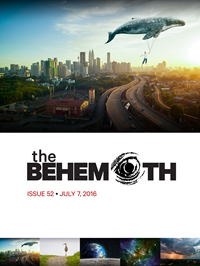Wonder on the Web
Issue 52: Links to amazing stuff.
The Strange Blissfulness of Storms
We’ve been getting a lot of stormy weather lately in Chicagoland, where Christianity Today has its headquarters, and this article from Nautilus got us thinking about what we find so energizing about a good storm. Our editor, Ted, says that since he and his college roommate both grew up in Hawaii, “Midwest storms were a treat. We wrecked a lot of stuff our freshman year in college because we kept the windows open during storms—we didn't want to muffle the thunder at all.” The thrill of extreme weather isn’t only psychological. Research done by biometeorologists—scientists who study the effect of atmospheric processes on organisms and ecosystems—says it might have something to do with the onslaught of charged particles, called ions, that comes with storms.
Mapping the Creatures Living Beneath Our Feet
We probably don’t think about it much, but the ground beneath us is quite alive. To show us just how diverse our planet’s soil is, a team of more than 120 soil experts from the Joint Research Centre has collaborated on this brand new collection of maps, called the Global Soil Biodiversity Atlas. National Geographic’s All Over the Map blog warns that reading the atlas “might just turn you into a soil geek.” Speaking of rainstorms:
You know that earthy smell after a good rain? It comes from a compound called geosmin that’s made by Streptomyces bacteria and released when they die. The human nose is extremely sensitive to it. It’s the same compound that gives beets their earthy flavor.
Download the free digital version of the atlas here.
‘Brain Melting’ Optical Illusions
We hope you had as much fun reading our 3D issue as we had creating it! We’re still on a bit of a 3D kick, so we thought we’d share some awesome artwork we came across, thanks to Rebecca, our science editor. Kurt Wenner’s art is 2D (you can put away your anaglyph glasses now), but his skills in forced perspective are incredible. Don’t miss the Pavement Art galleries included in his online portfolio. And because chalk art is fun and summery, here’s a Buzzfeed-curated list of “33 Brain-Melting Works of 3D Sidewalk Chalk Art.”
The Blind Astronomer of Nova Scotia
As a child, Ted Doucette was diagnosed with congenital cataracts, and had to have the lenses of his eyes removed and his pupils widened. Because of this, Doucette is legally blind, but his eyes pick up more light at night—which means that he can actually see the stars better than most people can. When Doucette realized what his unique eyesight had given him, he decided to become an astronomer and built his own observatory, named “Deep Sky Eye.” “During the day, I see everything extremely bright; everything is overexposed. … But at nighttime, the tables are turned, and it’s like a curtain’s been lifted,” he says.
If this video has left you in awe like us, you might enjoy looking back at this Behemoth article from CT’s astronomer colleague, Richard Hammar. And then you can read about Paul Bogard’s journey into Class 2 darkness, or Morgan Lee’s ruminations on the Carrington Flare of 1859.
Also in this Issue
Issue 52 / July 7, 2016- Editor's Note from July 07, 2016
Issue 52: Dreams, animal GPS, and astronaut churches. /
- What Dreams Are Really Made Of
Why we’ve always tried to find transcendent meaning in an ordinary, everynight event. /
- What Color Is North?
How birds and other animals travel so far so accurately. /
- Bless Thou the Astronauts
How the church shaped early lunar exploration. /
- A Dream Song (II)
“The stars are spinning their threads.” /


